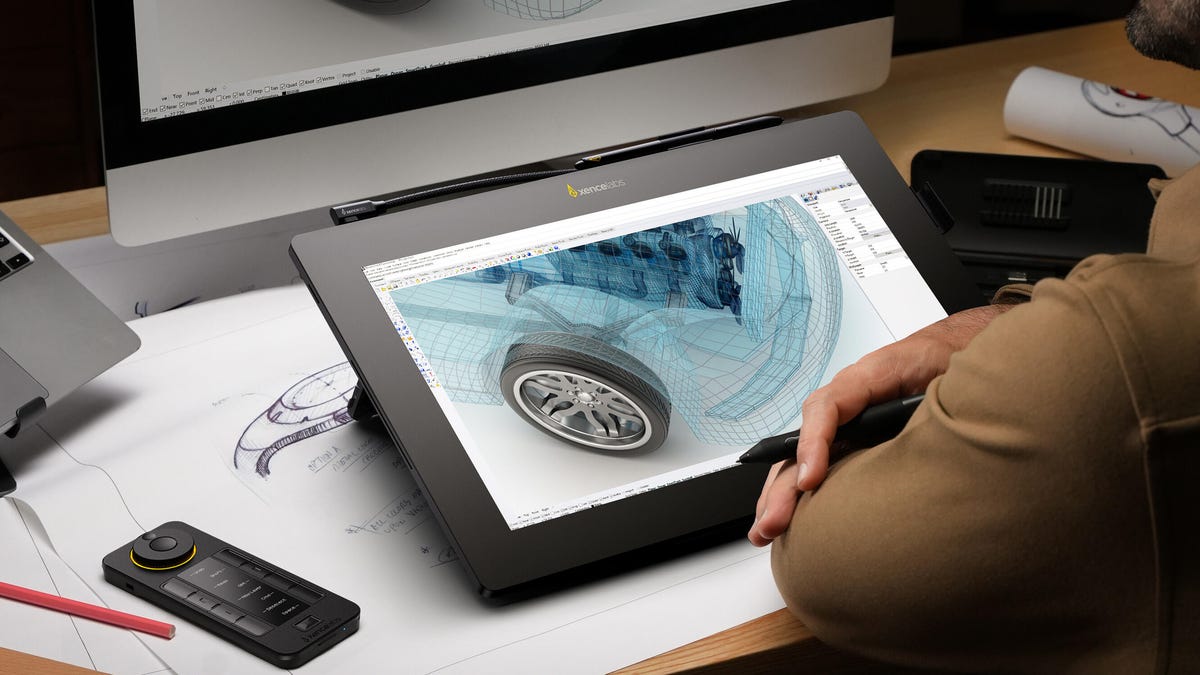Xencelabs, a relatively new company (circa 2019) founded by some Wacom emigres, debuts a follow-on to its 24-inch Pen Display 24, a 16-inch pro graphics display tablet designed to be a lightweight, compact alternative to Wacom’s Cintiqs and 13-inch Movink. As a second display for your PC, Mac or Linux system, tablets like these benefit from the increased horsepower and more seamless cross-application file support that you get when attached to a full system compared to an iPad. Plus, the Wacom-compatible (EMR) styluses have a more flexible set of nib options than the Apple Pencils, for those of us who like a little more friction than Apple’s. And the etched surface, for better tooth and less glare, is built in.
The Pen Display 16 comes in two versions. Essentials includes a USB-C cable, cleaning cloth, two pens with spare nibs and accessories, glove and a carrying case. The kitchen-sink bundle adds with an external, programmable remote, a hub and multiple cables for other types of connections (like HDMI and DisplayPort), charging adapter and a dual-angle stand (18.3 and 32 degrees). They’re aggressively priced compared to Wacom’s offerings — the Cintiq Pro 16 is $1,600 — but they’re not cheap at $999 for Essentials and $1,249 for the bundle.
The bundle ships first — at the end of May — followed by Essentials at the end of June, and you’ll be able to buy the Xencelabs Desktop Easel by itself this summer. The Quick Keys remote is the same as that available for the 24-inch model, and the stand has a built-in VESA mount with a quick release, a nice touch.
Like the iPad Pros launched on May 7, the Xencelabs (and Movink) incorporate OLED displays; the Xencelabs is the largest of all, which may make it a more practical second display for some folks. It’s not exceptionally light, weighing 2.7 pounds (1.2 kilograms), as much as a light business laptop; for reference, that’s about the same as a 13-inch M3 MacBook Air. The Xencelabs also has the highest resolution screen of the bunch, 4K, with a pixel density of 275ppi. High pixel density is more important for graphics than a lot of other uses because you generally need to zoom in a lot.
Other specs include:
- Five calibrated spaces: Adobe RGB (98% coverage), P3 (98%), sRGB (99%), Rec 2020 (82%) and Rec 709 (99%).
- Two pens (thin and fat) with similar design and feel to Wacom’s to accommodate muscle memory, as well as compatibility with third party styluses.
- Quick Keys remote supports up to 40 shortcuts per application with context-sensitive labels and works up to 53 hours per charge (it supports fast charge).
- Two USB-C ports, one on the short edge and one on the long, for greater flexibility.
- Battery free pen, 8,192 levels of sensitivity and other typical specs for EMR styluses
The Pen Display 16 has some potential drawbacks, depending upon your needs. It doesn’t support ChromeOS and Android, nor does it support touch, both of which Wacom’s mobile-focused Movink offer. I have mixed feelings about the latter; it can be very convenient, but it can also introduce wonkiness for palm rejection.
I’ve got a review of it in the works, so stay tuned for more details.

Wanda Parisien is a computing expert who navigates the vast landscape of hardware and software. With a focus on computer technology, software development, and industry trends, Wanda delivers informative content, tutorials, and analyses to keep readers updated on the latest in the world of computing.


